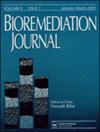利用产生双加氧酶的基因工程恶臭假单胞菌降解土壤中的头孢曲松
IF 1.9
4区 环境科学与生态学
Q3 ENVIRONMENTAL SCIENCES
引用次数: 4
摘要
本文章由计算机程序翻译,如有差异,请以英文原文为准。
Biodegradation of ceftriaxone in soil using dioxygenase-producing genetically engineered Pseudomonas putida
Abstract In this study, the degradability of the antibiotic Ceftriaxone was investigated with the help of genetically engineered Pseudomonas putida, in which the gene producing the enzyme catechol 2 and 3 dioxygenase was designed and then inserted into the pUC18 plasmid and replicated by E. coli. It was purified and extracted and transformed into Pseudomonas putida. Finally, the degradation rate of Ceftriaxone by this bacterium in spiked soil was evaluated using the HPLC measurement technique. Finally, the kinetics of Ceftriaxone degradation by genetically engineered Pseudomonas putida was investigated using zero, first, and second –order kinetic models for all factors. The results of HPLC measurement showed that the biodegradation of ceftriaxone in spiked soil was significant by genetically engineered P. putida compared to autoclaved soil inoculated by wild P. putida and normal soil with normal microbial flora (p < 0.001) and this bacterium was able to degrade ceftriaxone by 69.53% and kinetic modeling showed that the rate of removal by genetically engineered Pseudomonas putida follows the zero-degree reaction model. These findings indicate that Pseudomonas putida, which produces Catechol 2,3-dioxygenase, can be useful and practical in the biological treatment of environment from cephalosporins.
求助全文
通过发布文献求助,成功后即可免费获取论文全文。
去求助
来源期刊

Bioremediation Journal
ENVIRONMENTAL SCIENCES-
CiteScore
5.30
自引率
0.00%
发文量
36
审稿时长
9 months
期刊介绍:
Bioremediation Journal is a peer-reviewed quarterly that publishes current, original laboratory and field research in bioremediation, the use of biological and supporting physical treatments to treat contaminated soil and groundwater. The journal rapidly disseminates new information on emerging and maturing bioremediation technologies and integrates scientific research and engineering practices. The authors, editors, and readers are scientists, field engineers, site remediation managers, and regulatory experts from the academic, industrial, and government sectors worldwide.
High-quality, original articles make up the primary content. Other contributions are technical notes, short communications, and occasional invited review articles.
 求助内容:
求助内容: 应助结果提醒方式:
应助结果提醒方式:


